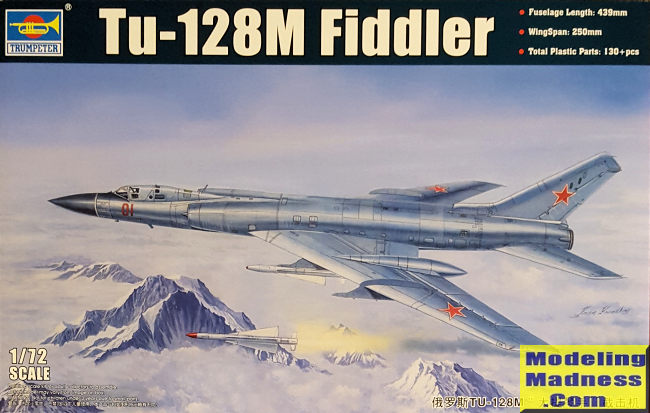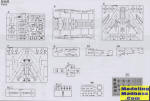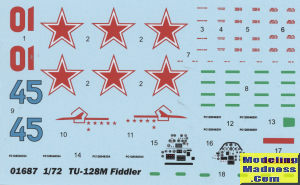
| KIT #: | 01687 |
| PRICE: | $20.00 'used' |
| DECALS: | Two options |
| REVIEWER: | Scott Van Aken |
| NOTES: | 2018 release |

| HISTORY |
Iosif Nezval of Tupolev Design Bureau led development of the new interceptor aircraft. The work began in 1958, based on an existing single prototype of the unsuccessful Tu-98 supersonic bomber. The military designation of the interceptor was at first Tu-28, but it was changed in 1963 to Tu-128, identical to the designation used by the OKB.
The Tu-128 had a broad, low/mid-mounted swept wing carrying the main landing gear in wing-mounted pods, and slab tailplanes. Two Lyulka AL-7F-2 turbojet engines were mounted in the fuselage. The two-man crew of pilot and navigator were seated in tandem.
The Tu-128, with its maximum weight of 43 tonnes, was the heaviest fighter to enter service. It was a interceptor with high wing loading, unsophisticated but reliable avionics and poor visibility. It was not an agile aircraft. It was intended to combat only NATO bombers like the B-52, not engage in dogfights with smaller aircraft.
The interceptor made its initial public appearance in the 1961 Tushino air parade. Western experts, unaware that the bulge on the belly carried testing instruments, mistook it for a large ventral radar for a mixed interceptor/AWACS role. The production version lacked the bulge and had a large nose radome housing a radar, known as RP-S Smerch, having a detection range of about 50 km (31 mi) and a lock-on range of about 40 km (25 mi).
Armament of the Tu-128 was four Bisnovat R-4 air-to-air missiles (known as K-80 during development; NATO reporting name AA-5 'Ash'). Usually two of them were R-4Rs with semi-active radar homing and two were R-4T infrared-homing missiles, with the former on the outer pylons and the latter on the inner underwing pylons. There was no internal weapons bay.
Production of the Tu-128 ended in 1970 with a total of 198 aircraft having been built.
| THE KIT |
 Prior
to this particular kit, the only other Tu-128 in 1/72 scale was by AModel.
That one was very much a short run kit with a multiple piece fuselage, thick
sprue gates and generally a lot of work to make a nice model from it. This
one by Trumpeter is everything we have come to expect from them in terms of
detailing and I'm willing to bet that it will build nicely as well.
Prior
to this particular kit, the only other Tu-128 in 1/72 scale was by AModel.
That one was very much a short run kit with a multiple piece fuselage, thick
sprue gates and generally a lot of work to make a nice model from it. This
one by Trumpeter is everything we have come to expect from them in terms of
detailing and I'm willing to bet that it will build nicely as well.  photo
etch fret. The airframe is flipped over and the rest of the main gear is
built up. Gear doors and pylons are then attached. The last items are the
four large air to air missiles and a number of photo etch antennas.
photo
etch fret. The airframe is flipped over and the rest of the main gear is
built up. Gear doors and pylons are then attached. The last items are the
four large air to air missiles and a number of photo etch antennas. | CONCLUSIONS |
Overall, it looks like a nice kit. Trumpeter kits are generally well engineered even if they occasionally have shape gaffes. One thing for sure, this one will take up a fair amount of shelf space when done.
| REFERENCES |
https://en.wikipedia.org/wiki/Tupolev_Tu-28
September 2021
Copyright ModelingMadness.com. All rights reserved. No reproduction in part or in whole without express permission.
If you would like your product reviewed fairly and quickly, please contact the editor or see other details in the Note to Contributors.